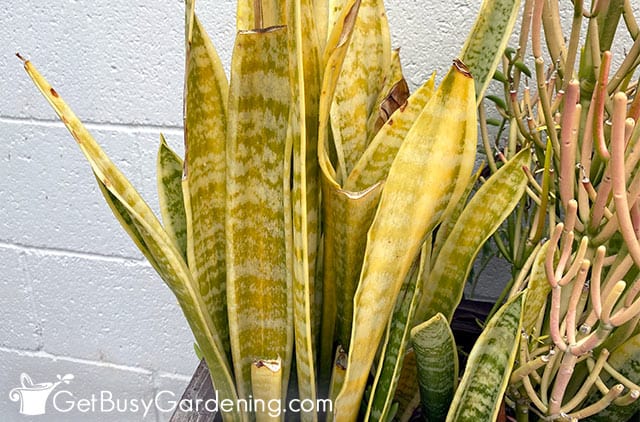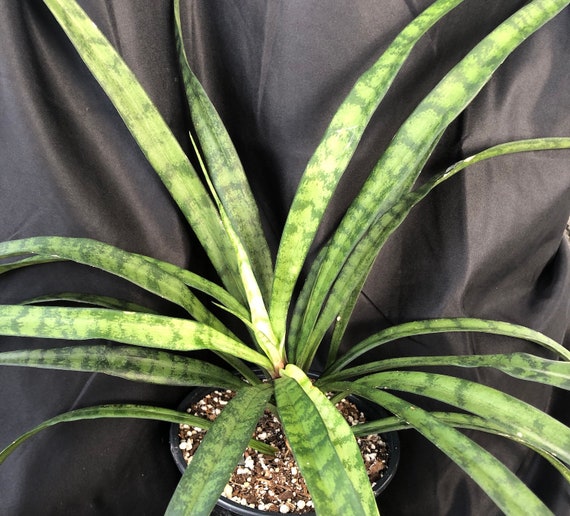The Best Guide To Snake Plant Leaves Turning Yellow
Wiki Article
Examine This Report on Snake Plant Leaves Turning Yellow
Table of ContentsExcitement About Snake Plant Leaves Turning YellowThe Main Principles Of Snake Plant Leaves Turning Yellow Snake Plant Leaves Turning Yellow Fundamentals ExplainedTop Guidelines Of Snake Plant Leaves Turning YellowHow Snake Plant Leaves Turning Yellow can Save You Time, Stress, and Money.
Below are seven reasons your serpent plant's leaves could be transforming yellow and how to fix it. Several different plant issues can trigger yellow leaves, or chlorosis. Chlorosis happens when plants do not have the micronutrients they need to create chlorophyll, that makes foliage green and enables plants to transform sunshine into food.Serpent plants are drought forgiving thanks to their succulent leaves. These plants grow finest in loose, well-drained soil that's allowed to dry out entirely in between waterings and may only need water when each month throughout winter. Overwatering can stop roots from absorbing dampness and nutrients that the plant requires and can even cause origin rot.
A potbound plant can not take in nutrients from the soil. If your serpent plant is jammed or outgrowing its pot, this might be the cause of yellow fallen leaves.
See to it the plant has intense, indirect light and continually cozy temperatures, and water only once the dirt has completely dried out. Keep an eye out for problems and capture them early on to keep your plant looking healthy and stunning.
Unknown Facts About Snake Plant Leaves Turning Yellow
If the fallen leaves on your snake plant are getting soft, it's usually a sign of way too much water. Serpent plants shop water in their leaves and if they're overwatered, the fallen leaves can become soft and mushy. If you believe your serpent plant is being overwatered, permit the soil to dry completely prior to sprinkling once more.Yes, some yellowing is regular and to be expected on older leaves, particularly as serpent plants age. If the plant is otherwise healthy and the fallen leaves are just gently yellowed then there is no reason for concern. Nonetheless, if the leaves are dramatically yellowed or if there are other indicators of distress then it's ideal to do something about it.
Dead leaves can supply a home for parasites and diseases, which can after that spread to the rest of the plant. To remove a dead leaf, merely reduce it off at the base with a sharp blade or scissors. Make sure to disinfect your cutting device in between cuts to avoid the spread of disease.
This can vary depending upon the size of the pot, the sort of potting mix, and the temperature level and moisture levels. In basic, snake plants must be watered every one to two weeks. Throughout the winter months, you can decrease watering to when a month. my explanation Snake Plant Leaves Turning Yellow. If you assume your serpent plant has actually been overwatered, the initial step is to stop sprinkling it.
How Snake Plant Leaves Turning Yellow can Save You Time, Stress, and Money.
With a little investigation, you ought to have the ability to find out the cause and take actions to fix the issue and have a healthy serpent plant.The snake plant is an awesome houseplant. The serpent plant is among those plants that are great for expanding indoors in a terrarium, Serpent plants can grow rather large, yet they also often tend to be rather low-maintenance. That does not indicate you should not take note of their appearance. Expect your near the bottom due to an absence of nutrients or other problems.
When the dirt is overwatered, the plant cells absorb more water than they can save. Drooping snake plant fallen leaves are caused by soaked-up fallen leave cells losing their suppleness.
It is, as a result, more probable that your plant will identify yellow spots on its fallen leaves if you overfeed it with plant food throughout winter season. The fallen leaves of serpent plants are additionally vulnerable to yellowing when overfed, particularly if the origins are fragile. Repotting your yellowing, watering only when the dirt dries out, and providing optimal temperature level and light problems can conserve it.
The smart Trick of Snake Plant Leaves Turning Yellow That Nobody is Talking About

Your can be removed by visit the website cutting off the yellow pointers. The trimmed fallen leaves ought to grow longer if they are watered effectively and have optimal light and temperature conditions. It is essential to bear in mind that the sharp suggestions will not grow back, triggering them to stick out from the remainder of the fallen leaves.
It will not take long for the leaves to grow back and grow like the healthy fallen leaves around them. At the same time, you can eliminate affected leaves from the base of the plant. The shows that it's obtaining way too much or insufficient light or nutrients. The key message is to permit the serpent plant time to recover.

The Ultimate Guide To Snake Plant Leaves Turning Yellow
Several of the most typical causes are noted below (Snake Plant Leaves Turning Yellow). Sansevierias like completely dry climates and like little water kept at a gap of one or two times weekly in summertime and month-to-month in wintertime. When the water dose obtains out of control, your Sansevieria will endure from overwatering. One of the most common trouble provided by overwatering is origin rot causing mushy origins and stems with a nasty scent.Report this wiki page